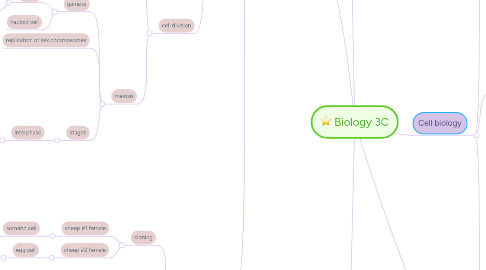
1. Micro biology
1.1. protist
1.1.1. disease
1.1.1.1. malaria
1.1.1.2. treatment
1.1.1.2.1. antibiotic
1.1.2. types
1.1.2.1. plant like
1.1.2.1.1. autotroph
1.1.2.2. animal like
1.1.2.2.1. amoeba
1.1.2.3. fungi like
1.1.2.3.1. slimemolds
1.1.3. chrecteristics
1.1.3.1. cilia
1.1.3.2. flagella
1.1.3.3. unicellular
1.1.3.4. eukaryote
1.2. fungi
1.2.1. prevention
1.2.1.1. fungicide
1.2.2. reprduction
1.2.2.1. asexual
1.2.2.1.1. fragmentation
1.2.2.2. sexual
1.2.2.2.1. spores
1.2.3. disease
1.2.3.1. mycosic
1.2.3.1.1. ringworm
1.2.3.1.2. athletes foot
1.2.4. types
1.2.4.1. chitin
1.2.4.1.1. crustation shells
1.2.4.2. yeast
1.2.4.2.1. unicellular
1.2.4.3. molds
1.2.4.3.1. hyphae
1.2.4.3.2. industry
1.2.4.3.3. mycellium
1.2.4.4. mushrooms
1.2.4.4.1. recyclers
1.2.4.4.2. decomposers
1.2.5. structure
1.2.5.1. cell wall
1.2.5.2. eukariote
1.2.5.3. heterotroph
1.3. virus
1.3.1. disease
1.3.1.1. treatment
1.3.1.1.1. vaccine
1.3.1.1.2. no vaccine
1.3.1.2. prevention
1.3.1.2.1. good hygiena
1.3.2. structure
1.3.2.1. DNA or RNA
1.3.2.2. capcid
1.3.2.3. tail fibers
1.3.2.4. nucleic acid
1.3.2.5. collar
1.3.3. reproduction
1.3.3.1. bacterophage
1.3.3.2. lytic cycle
1.3.3.3. virus replication
1.4. bacteria
1.4.1. disease
1.4.1.1. treatment
1.4.1.1.1. antibiotic
1.4.1.1.2. probiotic
1.4.1.2. E. coli
1.4.1.3. diarrhea
1.4.1.4. salmonella
1.4.2. characteistics
1.4.2.1. unicellular
1.4.2.2. cilia
1.4.2.3. prokayote
1.4.2.4. capsule
1.4.2.5. flagella
1.4.3. reproduction
1.4.3.1. asexual
1.4.3.1.1. binary fission
1.4.3.1.2. mitosis
1.4.4. industry
1.4.4.1. recylers
1.4.4.1.1. saprophytes
1.4.4.2. pollution control
1.4.4.2.1. bio remediation
1.4.4.3. aobiotics
1.4.4.3.1. yogurt
1.4.5. shapes
1.4.5.1. coccus
1.4.5.2. bacillus
1.4.5.3. spinillum
1.4.6. eubacteria
1.4.6.1. paramecium
1.4.6.2. halophiles
1.4.6.3. diarrhea
1.4.6.4. strepthroat
1.4.7. archaebacteria
1.4.7.1. thermophiles
1.4.7.2. methanogens
2. Genetics
2.1. DNA
2.1.1. genes
2.1.1.1. Punnett Square
2.1.1.1.1. tool to help predict offspring
2.1.1.1.2. genotype
2.1.1.1.3. phenotype
2.1.1.2. alleles
2.1.1.2.1. recessive
2.1.1.2.2. dominant
2.1.1.2.3. heterozygous
2.1.1.2.4. homozygous
2.1.1.3. mutations
2.1.1.3.1. harmless
2.1.1.3.2. abnormal
2.1.2. chromosomes
2.1.2.1. somatic cell
2.1.2.1.1. not a sex cell
2.1.2.1.2. 46 chromosomes
2.1.3. structure
2.1.3.1. double helix
2.1.3.1.1. nucleotide
2.1.3.1.2. complimentary base pairs
2.1.4. cell division
2.1.4.1. mitosis
2.1.4.1.1. Stages
2.1.4.1.2. somatic cell's
2.1.4.2. meiosis
2.1.4.2.1. gamete
2.1.4.2.2. replication of sex chromosomes
2.1.4.2.3. stages
2.2. genetic engineering
2.2.1. cloning
2.2.1.1. sheep #1 female
2.2.1.1.1. somatic cell
2.2.1.2. sheep #2 female
2.2.1.2.1. egg cell
2.2.2. GMO's
2.2.2.1. Genetically Modified Organism's
2.2.2.1.1. industry
2.2.2.2. genetic material has been altered
3. internal systems
3.1. circulatory system
3.1.1. function
3.1.1.1. transport
3.1.1.1.1. nutrients
3.1.1.1.2. oxygen
3.1.1.2. collects waste substanced
3.1.1.2.1. carbon dioxide
3.1.2. structure
3.1.2.1. superior and inferior vena cava
3.1.2.1.1. right atrium
3.1.3. disease
3.1.3.1. stroke
3.1.3.2. Cardiomyopathy
3.1.3.3. hypertension
3.1.3.4. prevention/treatment
3.1.3.4.1. keep blood pressure low
3.1.3.4.2. eat healthy
3.1.3.4.3. exercise
3.1.3.4.4. frequent check-ups
3.2. digestive system
3.2.1. structure
3.2.1.1. mouth/teeth
3.2.1.1.1. salivary glands
3.2.1.1.2. physically breaks food down
3.2.2. disease
3.2.2.1. acid reflux
3.2.2.2. stomach ulcer
3.2.2.3. celiac disease
3.2.2.4. treatments
3.2.2.4.1. eat healthy
3.2.2.4.2. eat smaller portions
3.2.2.4.3. aspirin and ibuprofen
3.2.2.4.4. gluten-free diet
3.3. respiratory system
3.3.1. structure
3.3.1.1. nose/mouth
3.3.1.1.1. epiglotis
3.3.2. disease
3.3.2.1. bronchitis
3.3.2.2. lung cancer
3.3.2.3. Cystic Fibrosis
3.3.2.4. treatment
3.3.2.4.1. inhaler
3.3.2.4.2. chemotherapy
3.3.2.4.3. pancreatic enzyme supplements
3.3.2.4.4. physiotherapy
4. Cell biology
4.1. transport
4.1.1. diffusion/concentration gradient
4.1.1.1. simple diffusion
4.1.1.1.1. high concentration gradient to a low concentration gradient until equilibrium
4.1.1.2. facilitated diffusion
4.1.1.2.1. select molecules cross the membrane using carrier protein (high to low concentration gradient)
4.1.2. osmosis
4.1.2.1. solvent
4.1.2.2. solute
4.1.2.2.1. isotonic
4.1.2.2.2. hypotonic
4.1.2.2.3. hypertonic
4.1.3. active transport
4.1.3.1. ATP (Energy)
4.1.3.1.1. low to high concentration gradient
4.1.4. passive transport
4.1.4.1. high to low concentration gradient (no energy required)
4.1.5. bulk transport
4.1.5.1. exocytosis
4.1.5.1.1. transports materials out of the cell
4.1.5.2. endocytosis
4.1.5.2.1. transports materials into the cell
4.1.5.2.2. phagocytosis
4.1.5.2.3. pinocytosis
4.2. macromolecules
4.2.1. carbohydrates
4.2.1.1. monosaccharide
4.2.1.1.1. glucose
4.2.1.2. disaccharide
4.2.1.2.1. glucose + glucose =
4.2.1.2.2. glucose + fructose =
4.2.1.3. polysaccharide
4.2.1.3.1. starch
4.2.1.3.2. glycogen
4.2.1.3.3. cellulose
4.2.1.3.4. chitin
4.2.2. proteins
4.2.2.1. structure
4.2.2.1.1. amino acid
4.2.2.1.2. polypeptide/protein
4.2.2.1.3. importance of structure
4.2.2.2. function
4.2.2.2.1. enzymes
4.2.2.2.2. transport
4.2.3. nucleic acids
4.2.3.1. function
4.2.3.1.1. DNA
4.2.3.1.2. RNA
4.2.3.2. cytosine & guanine
4.2.3.3. adenine & thymine
4.2.3.4. structure
4.2.3.4.1. nucleic acid
4.2.3.4.2. nucleotide
4.2.4. lipids
4.2.4.1. types
4.2.4.1.1. fat/triglyceride
4.2.4.1.2. phospholipid
4.2.4.1.3. steroid
4.2.4.2. structure
4.2.4.2.1. glycerol
4.2.4.2.2. fatty acid
4.3. cell structures
4.3.1. animal cell
4.3.1.1. mitochondria
4.3.1.1.1. power house of the cell
4.3.1.2. ribosomes
4.3.1.2.1. Synthesizes proteins
4.3.1.3. cell membrane
4.3.1.3.1. controls movement of materials in/out of cell
4.3.1.4. nucleolous
4.3.1.4.1. Make ribosomes
4.3.1.5. Golgi body
4.3.1.5.1. storing, packaging of cellular products
4.3.1.6. small vacuole
4.3.1.6.1. store food, water, waste (plants need to store large amounts of food)
4.3.1.7. smooth and rough ER
4.3.1.7.1. makes products like hormones and lipids
4.3.1.7.2. rough ER has ribosomes on it
4.3.1.8. lysosome
4.3.1.8.1. breaks down larger food molecules into smaller molecules
4.3.1.8.2. digests old cell parts
4.3.1.9. cytoplasm
4.3.1.9.1. supports /protects cell organelles
4.3.2. plant cell
4.3.2.1. cell wall
4.3.2.1.1. supports (grow tall)
4.3.2.1.2. protection
4.3.2.2. large vacuole
4.3.2.2.1. store food, water, waste (plants need to store large amounts of food)
4.3.2.3. chloroplast
4.3.2.3.1. uses energy from sun to make food for the plant (photosynthesis)
4.3.2.4. plastids
4.3.2.4.1. breaks down larger food molecules into smaller molecules
4.3.2.4.2. digests old cell parts
